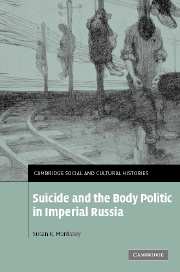Book contents
- Frontmatter
- Contents
- List of illustrations
- List of figures
- List of tables
- Acknowledgments
- Note on transliteration, translations, and dates
- List of abbreviations
- Introduction
- Part I Public order and its malcontents
- Part II Disease of the century
- Part III Political theology and moral epidemics
- 10 Freedom, death, and the sacred
- 11 Children of the twentieth century
- Epilogue
- Selected bibliography
- Index
11 - Children of the twentieth century
Published online by Cambridge University Press: 18 July 2009
- Frontmatter
- Contents
- List of illustrations
- List of figures
- List of tables
- Acknowledgments
- Note on transliteration, translations, and dates
- List of abbreviations
- Introduction
- Part I Public order and its malcontents
- Part II Disease of the century
- Part III Political theology and moral epidemics
- 10 Freedom, death, and the sacred
- 11 Children of the twentieth century
- Epilogue
- Selected bibliography
- Index
Summary
We, people of the twentieth century, without faith, without hope, without the desire to live. Neither Christ, nor socialism, nor man exists for us. Nothing exists except for thought [mysl'], and thought leads to suicide.
Suicide note, 1911Time seemed to quicken in early twentieth-century Russia, propelling with it the transformation of space and the human being. As the psychiatrist P. Ia. Rozenbakh wrote for a popular magazine in 1909: the “mind-whirling speed” of technical innovation had spurred unprecedented economic development – large-scale factories, the growing distinctions between capital and labor, the cult of money, the market of consumer goods – and this, in turn, had transformed the city into a site of seduction, danger, and agitation. “Along the streets of our Babylons from morning till evening rush the electric trams, automobiles, carriages; all of these weapons of accelerated movement threaten one another and pedestrians with the danger of collisions and fill the air with warning signals thereby lending street life the character of constant anxiety.” Not only had the new economic and commercial landscape awakened appetites, fatigued the body, and strained the nervous system. The recent political struggles in Russia had also produced an “eternal anxiety” within the population. While some individuals may live “as if outside historical influences,” Rozenbakh noted, the technical, economic, cultural, and political conditions of contemporary Russia had left their imprint upon the majority, producing epidemic levels of neurasthenia, hereditary degeneration, and suicide.
- Type
- Chapter
- Information
- Suicide and the Body Politic in Imperial Russia , pp. 312 - 345Publisher: Cambridge University PressPrint publication year: 2007



